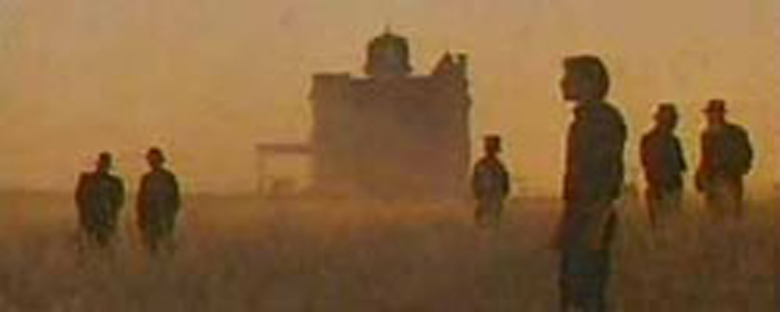Reviews
Terrence Malick
USA, 1978
Credits
Review by Rumsey Taylor
Posted on 10 July 2004
Source Paramount DVD
Days of Heaven must refer to the film’s central third, in which the main characters are each in a state of relative contentedness. Bill, along with his girlfriend Abby and sister Linda, flees to the Texas panhandle after a dispute results in the accidental death of one of his supervisors at a Chicago steel mill. The three gain employment on a farm during a wheat harvest (the film is set in the 1910s). Bill and Abby keep their relationship secret from everyone (the purpose for which is unexplained), and Abby accepts a courtship from the farmer (Sam Shepard, whose character remains nameless). The trio moves in to his gigantic, isolated mansion, and, temporarily, they seem pleased with the arrangement. Despite the deceit that enables this circumstance, it is the happiest the four will be.
If the allegory of Days of Heaven’s title is accepted, then the film’s bookending thirds are equivalent Hells. The opening location is summarized briefly: it is a dark warehouse with showers of welding sparks and open ovens. It is uncomfortable, and accompanies Bill’s accidental killing, his sin. The film’s later climax is a giant brush fire that engulfs the entire farm, and precedes a second killing. Given the analogy of the film’s opening and closing, hell is a visual manifestation of sin; the film’s climactic fire corresponds with the farmer’s discovery of Bill and Abby’s relationship, this after he has married her.
Terrence Malick favors naïve, apathetic characters in each of his three films. Holly and Kit, of Badlands, are youths preoccupied by an idealistic comprehension of fame. Here, Bill and Abby aren’t as established as the former pair, but seem similarly removed (the farmer, contrarily, is the most emotionally invested character in this film). Both films are escorted by the colloquial voice of a narrator. Linda (a teen) annotates this film with her descriptions of what she experiences; sometimes this is pertinent to the central romantic conflict, sometimes it is incidental. In many ways this film is predominantly about her, although it would seem otherwise given the film’s visual inheritance of her brother’s perspective. Additionally, Linda lacks investment in her brother’s strife. Even at the film’s end, she remains disaffected.
In this description Days of Heaven reads as a tragic, sorrowful film. This is enhanced by Ennio Morricone’s score, which abstractly evokes the rhythm and movement of the farmer’s endless fields of wheat. This description is entirely contrary to the film’s visuals, which are cohesively beautiful.
Days of Heaven’s cinematography is legendary. Technically, the film’s cinematographic merits are many: it is comprised principally of tremendous pans across the enormously vacant Midwestern locale (many of these shots pivot around the farmer’s mansion). These are interspersed among fluid tracking shots, close-ups, and even time-lapse photography. Frames of this film resemble epic neoclassical paintings (much of it is set in the “magic hour” at dawn and dusk). Even the most mundane or redundant action achieves a poetic beauty within Almendros’ lens, such as the labor of harvesting wheat.
Days of Heaven is significant, finally, for its contradiction. As with Badlands (the Malick film I prefer), its portrayal of idealistic young characters is at once defensive and insensitive — Malick emphasizes both his characters’ happiness and ignorance. This dilemma is acknowledged in the title, which implies that for Heaven to be existent so must Hell.
We don’t do comments anymore, but you may contact us here or find us on Twitter or Facebook.



